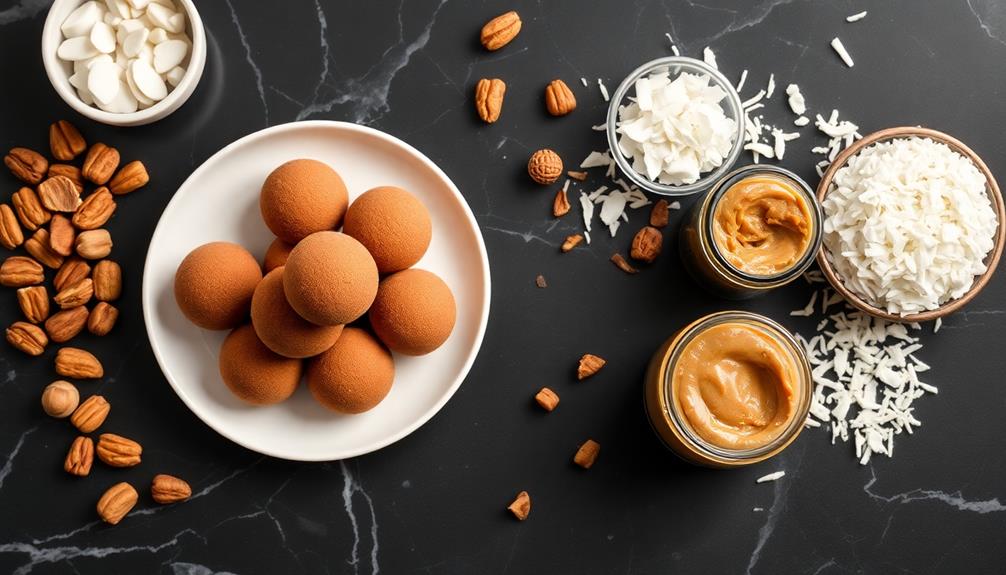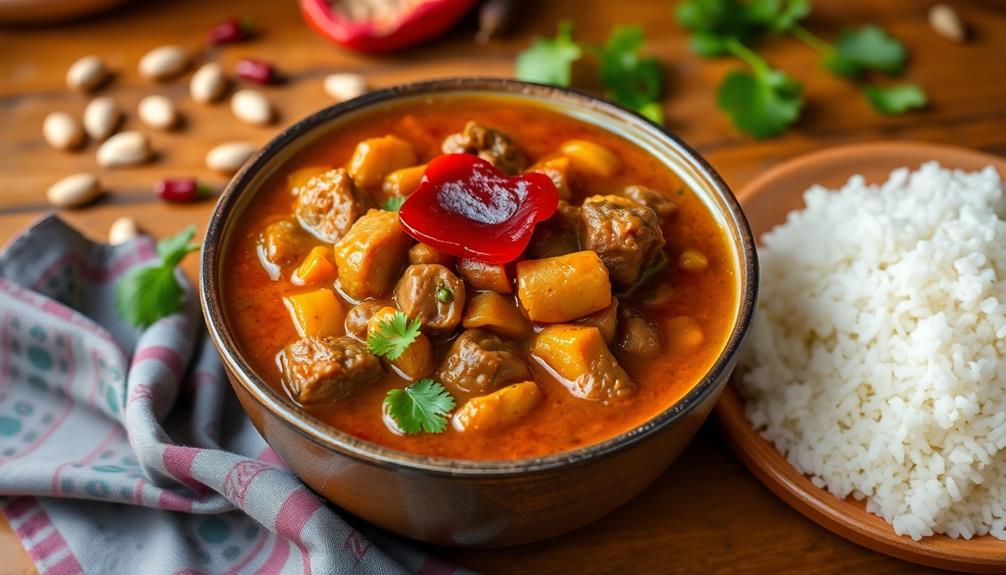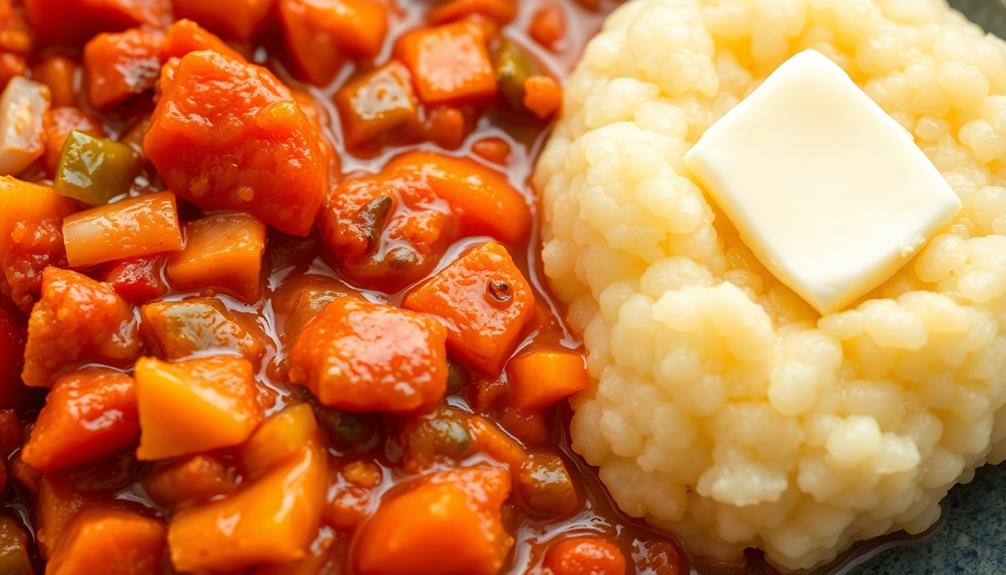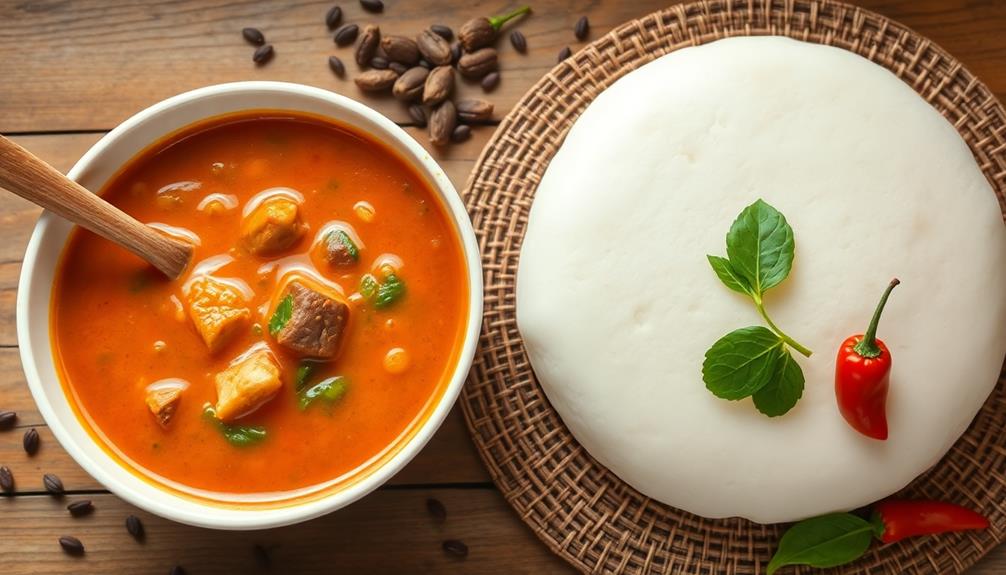Sadza, the beloved staple of Zimbabwe, is the perfect side dish that'll elevate any meal. Tracing its roots back to the 19th century, this thick, porridge-like cornmeal has become a symbol of national identity – a unifying force connecting generations. Requiring patience and attention, the cooking process involves gradually adding cornmeal to boiling water, stirring continuously to achieve the desired texture. Beyond its cultural significance, sadza provides essential carbohydrates and pairs wonderfully with stews, vegetables, and proteins. It's a comforting, filling option that's versatile enough to grace both daily meals and celebratory feasts. If you'd like to dive deeper into the rich history and culinary traditions of this Zimbabwean delicacy…
Key Takeaways
- Sadza, a staple food in Zimbabwe, can be an ideal side dish due to its versatility in pairing with various stews, vegetables, and meat-based accompaniments.
- The traditional recipe for sadza, made from finely ground maize flour, water, and salt, provides a filling and nourishing base for a balanced meal.
- The gradual addition of cornmeal to boiling water, followed by continuous stirring and simmering, results in a thick, creamy, and customizable texture of sadza.
- Sadza's cultural significance as a symbol of Zimbabwean identity and its role in bringing communities together make it a meaningful and unifying side dish.
- The versatility of sadza allows it to adapt to different regional flavors and modern culinary trends, making it a versatile and timeless side dish option.
History
The history of sadza, the staple food of Zimbabwe, can be traced back to the early 19th century. Initially, it was a simple dish made by boiling ground maize or millet into a thick porridge. Over time, the recipe evolved, and sadza became a cultural touchstone, deeply woven into the fabric of Zimbabwean society.
In the late 1800s, as the country transitioned from a collection of independent kingdoms to a British colony, sadza remained a constant in the lives of the local people. It was a reliable source of sustenance, a comfort food that could be prepared quickly and easily.
As the years passed, sadza's significance only grew, becoming a symbol of national identity and a unifying force in a rapidly changing world.
Today, sadza is more than just a side dish – it's a culinary tradition that connects Zimbabweans across generations and regions. Whether served with stew, relish, or simply on its own, this humble porridge continues to be an integral part of the Zimbabwean experience.
Recipe
Sadza is a traditional Zimbabwean staple food made from finely ground maize flour. It's a thick porridge-like dish that can be served as a side or as the main component of a meal.
Preparing sadza requires patience and attention, but the end result is a comforting and nourishing dish that's deeply rooted in Zimbabwean culture.
The process of making sadza involves carefully stirring and cooking the maize flour until it reaches the desired consistency. The texture can range from soft and creamy to firm and dense, depending on personal preference and the intended use of the sadza.
- Maize flour (mealie meal)
- Water
- Salt (to taste)
In a large pot, bring the water to a boil. Gradually add the maize flour, stirring constantly with a wooden spoon to prevent lumps from forming.
Reduce the heat to low and continue stirring the mixture until it thickens to your desired consistency, which can take 10-15 minutes. Season with salt to taste.
When cooking sadza, it's important to be patient and stir the mixture continuously to achieve the perfect texture.
Sadza can be served warm, often accompanied by stewed vegetables, meat, or relish. It's a versatile and filling dish that's an integral part of Zimbabwean cuisine.
Cooking Steps
Bring a pot of water to a rolling boil.
Gradually add the cornmeal, stirring the mixture continuously.
Cover the pot and let it simmer until the sadza is cooked through, then remove it from heat and serve.
Step 1. Bring Water to a Rolling Boil

First, bring 4 cups of water to a rapid boil in a large pot. You'll want the water to be at a full, rolling boil before adding the sadza. This ensures the cornmeal cooks thoroughly and develops the right texture.
While the water is heating, grab a sturdy wooden spoon – you'll need it for stirring the sadza vigorously later. Keep a close eye on the pot, adjusting the heat as needed to maintain that rolling boil.
Once the water is rapidly bubbling, it's time to gradually stir in the sadza. Start with small amounts, incorporating each addition fully before adding more. Continuous, vigorous stirring is crucial to prevent lumps from forming.
The sadza will thicken quickly, so be prepared to put some muscle into it. Keep stirring until the porridge reaches your desired consistency, then reduce the heat to low, cover, and let it simmer for a few more minutes.
Now you're ready for the next step in mastering this authentic Zimbabwean dish.
Step 2. Add Cornmeal Gradually

Once the water is at a rolling boil, you'll want to begin adding the sadza gradually. Start by sprinkling in a small amount of the cornmeal, stirring continuously to prevent lumps from forming.
As the sadza begins to thicken, you can add more cornmeal, a little at a time, continuing to stir vigorously.
The key is to go slowly and be patient. Adding the cornmeal too quickly can result in a lumpy, uneven texture. Take your time and allow the sadza to thicken to your desired consistency, which should be thick enough to hold its shape on a spoon.
Don't be tempted to add extra cornmeal, as this can make the sadza overly dense and dry.
Once you've reached the perfect thickness, reduce the heat to low and continue stirring for a few more minutes, allowing the sadza to fully cook through.
Step 3. Stir the Mixture Continuously

As you begin to add the cornmeal, it's crucial to stir the mixture continuously. This constant stirring ensures the cornmeal is evenly distributed, preventing any lumps from forming.
Steady, circular motions with a wooden spoon or whisk will help the sadza come together smoothly. Be mindful to keep a close eye on the pot, as the cornmeal can thicken quickly. Adjust the heat as needed, reducing it if the mixture becomes too dense.
Continuous stirring also helps the sadza develop its signature creamy texture. Don't be tempted to step away, as even a moment of neglect can lead to the sadza sticking to the bottom of the pot.
Persevere with your stirring, making sure to reach the edges and corners of the pot to incorporate all the cornmeal. This laborious but essential step is the key to achieving the perfect, lump-free Zimbabwean sadza.
Step 4. Cover and Simmer

After continuously stirring the sadza, it's time to cover the pot and let it simmer. Once the mixture has reached a thick, porridge-like consistency, reduce the heat to low and cover the pot with a lid. This will allow the sadza to gently simmer, helping it to further thicken and develop its signature texture.
As the sadza simmers, resist the urge to remove the lid and stir. Doing so will release valuable steam, slowing down the cooking process. Instead, let the sadza cook undisturbed for 10-15 minutes, or until it has reached your desired thickness.
Be mindful not to let the pot simmer for too long, as this can cause the sadza to become dry and crumbly.
Once the sadza has reached the perfect consistency, remove the pot from heat. It's now ready to be served hot, alongside your choice of stew, relish, or protein-rich dish. The covered simmering stage is a crucial step in achieving the smooth, creamy texture that makes Zimbabwean sadza so beloved.
Step 5. Remove and Serve

With the sadza having reached the perfect consistency, it's time to remove the pot from the heat.
Carefully lift the heavy pot off the stovetop, taking care not to spill any of the precious porridge. Once it's safely on the counter, it's time to serve.
Grab a large serving spoon and scoop generous portions of the thick, creamy sadza onto plates or bowls. Be sure to serve it piping hot, as that's when the flavor and texture are at their best.
If you have any accompaniments, like relish, stew, or meat, now is the time to add them. The sadza acts as a perfect base, soaking up all the delicious sauces and juices.
Invite your family or guests to dig in and enjoy this authentic Zimbabwean dish. The combination of the hearty sadza and the flavorful toppings is sure to satisfy even the heartiest of appetites. And for dessert, be sure to save room for a taste of our traditional mandazi recipe. These delicious, slightly sweet fried dough pastries are the perfect way to end a satisfying meal. So come and experience the flavors of Zimbabwe with us and indulge in a truly authentic dining experience.
Savor every bite and let the comforting flavors transport you to the vibrant streets of Zimbabwe.
Final Thoughts
Zimbabwean sadza remains a beloved staple for many, its comforting texture and flavor enduring through generations. This humble dish has withstood the test of time, adapting to the changing preferences and tastes of the people.
Its versatility allows it to complement a wide array of delicious stews, curries, and roasted meats, making it an indispensable part of the Zimbabwean culinary landscape.
As you savor the last bites of your perfectly prepared sadza, you can't help but feel a sense of connection to the rich cultural heritage it represents.
It's a testament to the ingenuity and resilience of the Zimbabwean people, who've embraced this dish as a symbol of their identity and pride.
Whether enjoyed as a comforting daily staple or a centerpiece of a celebratory feast, sadza remains a unifying force, bringing families and communities together around the table.
As you bid farewell to this extraordinary culinary journey, you know that the essence of Zimbabwean sadza will continue to enrich the lives of those who cherish it.
Frequently Asked Questions
Where Can I Find the Key Ingredients for Zimbabwean Sadza?
The key ingredients for Zimbabwean sadza can be found at your local African or international grocery store. You'll typically find maize meal or cornmeal, which are the main components in preparing this traditional Zimbabwean staple dish.
How Long Does It Typically Take to Prepare Sadza?
Preparing sadza typically takes about 30-45 minutes. You'll need to bring the water to a boil, then gradually add the cornmeal, stirring constantly until it reaches the desired consistency. The process requires patience but results in a delicious staple dish.
Is Sadza Gluten-Free?
Yes, sadza is gluten-free. It's made from cornmeal, which doesn't contain any gluten. So if you're following a gluten-free diet, you can enjoy this traditional Zimbabwean dish without any worries.
Can Sadza Be Reheated and Stored?
You can absolutely reheat and store sadza. It holds up well to reheating and won't lose its texture or flavor. Just be sure to store it properly in an airtight container in the fridge for up to a few days.
What Is the Best Way to Serve Zimbabwean Sadza?
The best way to serve Zimbabwean sadza is to dish it up hot, with a hearty stew or relish on the side. You can top it with sautéed vegetables, meat, or a dollop of peanut butter for extra flavor.










